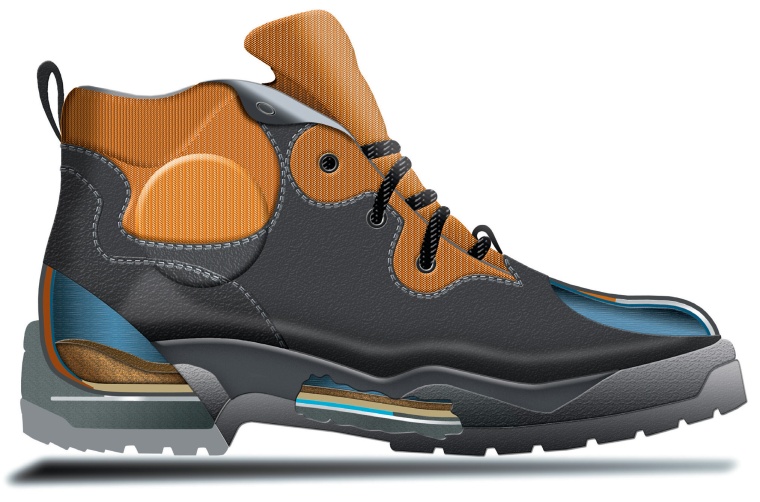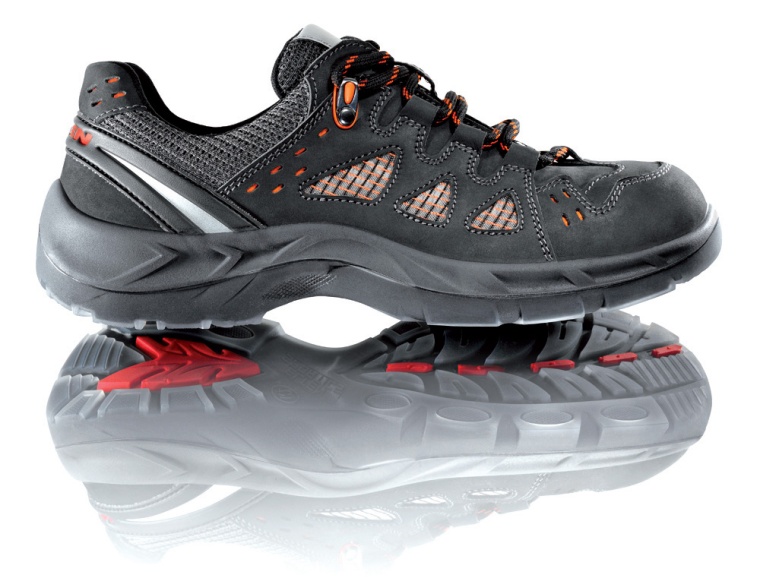Schuhfabrik van Elten: state-of-the-art safety shoes
Schuhfabrik van Elten: state-of-the-art safety shoes. Things are happening on the safety shoe market. A look at recent developments shows how the industry is seeking to combine ris...


Schuhfabrik van Elten: state-of-the-art safety shoes. Things are happening on the safety shoe market. A look at recent developments shows how the industry is seeking to combine rising safety standards with growing demands for wearing comfort. New materials are being mobilised to improve protection, comfort and the appearance of products. And accident risks are now being met by innovative developments.
The market for safety shoes is on the move. Manufacturers are increasingly using new, fashionable materials and concentrating more and more on wearing comfort as well as safety. Technical further development from the simple work shoe of yesteryear to the high-tech safety shoe of today is advancing with giant strides.
Risen standard and safety requirements, on the one hand, and growing demands by end consumers for design and wearing comfort, on the other, are the driving forces behind this development.
Growing Demands for Design and Comfort
The interplay of supply and demand has given brought about a whole series of improvements in the design and wearing comfort of safety shoes. As with fashion footwear, end consumers are calling for sporty models which are not instantly recognisable as working shoes. And more and more companies are discovering corporate design as a means of increasing their employees‘ motivation and loyalty. The time when safety shoes were thought of as clumsy and shapeless is long past.
Whoever buys a safety shoe today gets sportiness, safety and comfort united in a single product.
Not Every Shoe Is a Safety Shoe
Of the safety regulations international standards EN ISO 20344 to 20347 are decisive today. These standards make high demands of a modern safety shoe and cover their entire design. Thus, not every shoe can rightly claim to be a „safety shoe“. In fact a distinction is made between work, protective and safety shoes, of which increasing demands are being made.
Whereas work shoes do not have to have toe protection, protective shoes are required to be fitted with a toe cap which can withstand impact energy of 200 joule. And only if the toe cap can withstand twice the load of 200 joule can the shoe be called a safety shoe.
Toe Caps: Steel, Composite or Aluminium?
A toe cap with an energy absorption capacity of at least 200 joule is the characteristic feature of a safety shoe. It guards the toe area against falling objects and is normally made of steel. More recently, however, various manufacturers have brought onto the market shoes with protective toe caps of aluminium or composite. These have the advantage of being lighter and more comfortable than conventional steel toe caps.
What also distinguishes a good safety shoe is that the edge of the toe cap is padded at the point where it meets the shoe upper, so that, when the foot is bent, there are no pressure points. On request good shoemakers also fit extra-wide toe caps or include in their collections shoes in different fit forms.
Heel Caps: Stability for the Ankle
The back cap gives the foot firm lateral support in the heel area. The energy absorption capacity of the heel area must be at least 200 joule if it is to reduce injuries to the heel bone. Newly arrived on the market are also combined protection systems which enclose not only the heel area but also the ankle.
Special shoe upper cuffs like the Biomex Protection system introduced by Elten unite the necessary stability with sufficient mobility and offer preventive protection not only for the heel bone but also for the joint system.
Uppers: Combination of Safety and Design
The uppers must also meet high safety requirements when it comes to breaking force, strength and steam permeability of materials. Of especial importance, however, for wearing comfort and, of course, the appearance of the shoes is also the choice of material. While, because of its ability to adapt itself very rapidly to the individual foot form and the change in foot volume during the day, leather is the material most widely used here, it is no longer unrivalled: A large number of textile materials, which, besides being robust, are particularly impressive for their climate-regulating action, their pleasant wearing properties and their almost unlimited visual design potential has meanwhile captured the market.
However, what decisively marks out a good safety shoe are its inner qualities. The inner lining and the sole design, for example.
Inner Lining: Good Climate for Healthy Feet
The function of the inner lining is to ensure comfort. But that‘s not all. Modern inner linings today are real high-tech products, which with a mix of different textile components perform a number of functions. For example, they guarantee an active transfer of moisture from the inside of the shoe to the outside, enable rapid evaporation from the surface of the shoe and so ensure a pleasantly dry foot environment.
Inner linings with antimicrobial action also make an active contribution to foot health by ensuring that harmful fungi and bacteria cannot breed inside the shoe.
The latest developments in inner lining technology today are the so-called „spacer fabrics“. Their three-dimensional structure produces a pumping action during walking and so assists air circulation inside the shoe.
Sole Technology: Treading Safely and Comfortably
Modern soles are directly injected onto the shoe under computer and robot control. The materials which have been found to be most suitable are rubber, polyurethane (PU) and thermoplastic polyurethane (TPU). These materials are antistatic and fuel-resistant and are used in various combinations, as required. Here, too, innovative technologies now offer very new possible applications.
Modern manufacturing methods today enable up to four different materials with different properties to be used in an outer sole. In this way it will very soon be possible to assign special functions to individual parts of the sole. At safety shoe manufacturer Elten, for example, work is now being done to develop outer soles with marginal sole areas with profiles made of particularly slip-resistant materials and with middle foot areas incorporating pivotal points of particularly low-friction materials.
Sole concepts of this sort not only offer especial slip-resistance but also at the same time facilitate frequent turning and rotating movements in the workplace and so prevent joint problems.
Fit Forms: Comfort with Individuality
Meanwhile the trend is away from the conventional multi-width systems developed in the 1970s and towards so-called „foot type systems“, whose fit forms not only take into consideration the length and width of the foot but also e.g. the angular position of the ball of the foot and the length of the toes.
Thanks to new measuring techniques an optimum adaptation of the shoe to the respective foot type thus becomes possible. Good manufacturers therefore offer in every shoe size different fit forms that not only vary in length and width but are also precisely tailored to the different foot types. The service offering extends to orthopaedic adaptation of safety shoes to meet the individual needs of the customers.
New Standards through Active Product Innovations
The survey shows clearly that leading manufacturers are no longer merely responding to changes in customer demands and safety standards but are going onto the offensive. Thanks to new product developments such as special ankle protectors, new sole technologies and improved fit form systems the present standard of safety and comfort is being continuously further raised.
These, together with an attractive appearance, are the ingredients which go to make successful innovations in the safety shoe market.
By their research and development work leading manufacturers are repeatedly setting new standards here.
Contact:
Schuhfabrik van Elten GmbH,
Uedem, Germany
Tel. +49 180 382 63 58
Fax +49 180 335 83 63
markus@bremers.de
www.elten.com
most read

When the Internet stumbles: Why DNS is important
When DNS fails, the internet stumbles-AWS outage proves resilience and redundancy are vital for digital trust

VIP-Lounge Interview: Marco Mille, Global Head of Security, Siemens AG
VIP in the World of Security: Marco Mille, Global Head of Security at Siemens AG


Integrated and Futureproof: Traka’s Next Chapter
Interview with Stefni Oliver on Traka’s Vision for the Future

Security management, building security & perimeter protection: the winners of category E at the GIT SECURITY AWARD 2026
GIT SECURITY AWARD 2026: Security management, building security & perimeter protection - an overview of the most innovative solutions







